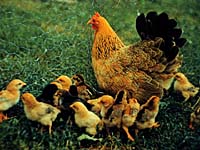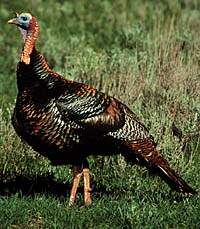
Chicken Management Hatching The development of a mechanical setter and hatcher has permitted the large scale production of chicks with little labour. While many of the eggs produced on farms are unfertilized, only those eggs which are fertilized will hatch. Fertilized eggs can be purchased from breeding operations, or by the successful mating of a rooster and a hen by natural methods or by using artificial insemination. Turkey production relies on the use of artificial insemination to produce fertile eggs. The continuous genetic selection for turkeys with large breast muscling has resulting in many breeds which are no longer capable of copulating because of their large and awkward size.
Fertile eggs are first incubated in a machine called a setter. This is a large insulated box containing many shelves which can be tilted back and forth. The tilting of the shelves permits the mechanical rotation of the fertilized egg to prevent the embryo from becoming attached to the egg shell. The embryo should remain in the center of the egg. If it becomes attached to the egg shell, it may fail to develop properly. The setter is heated to permit rapid development of the embryo and are maintained at a high humidity to prevent the egg from becoming dehydrated. The incubation time varies depending on the species of bird. Chickens are incubated for 21 days, while turkeys, ducks and geese will take 26-28 days before hatching.
Eggs are moved to the hatcher near the end of their incubation period. The hatcher is similar to the setter in that it is a warm and humid environment. The hatcher contains drawers in which the eggs will hatch. When it is time for the egg to hatch, the chick uses its egg tooth, a sharp horn on its beak to break through the egg shell. Chicks will remain in the hatcher for 12 - 24 hours during which their down will dry.
After the chicks are removed from the hatcher, they receive a vaccination and are sorted based on their sex. They are then shipped in cardboard or plastic boxes to the commercial farms.
Housing
Large barns are built to house thousands of birds. Meat producing birds are raised on straw bedding, while laying hens are housed in groups of 2 - 4 birds in rows of cages. There have been many complaints about the lack of space for egg laying birds to exercise and move while housed in cages. Egg laying birds could be housed on floors with litter similar to meat producing birds if a nesting area is provided. However, this program is less popular with producers in North America because it results in a larger number of damaged and dirty eggs. Birds housed in cages are also less likely to peck and kill other birds. The cage system is still currently used in Saskatchewan because it is still the most economical program and provides a better quality of life when compared to alternative housing programs. Ducks, geese and turkeys are commonly raised indoors in Saskatchewan. They can however be raised outdoors on pasture during the warmer months, yet they must be protected from predators.
Poultry barns must be disinfected between production cycles to reduce the transmission of disease from one cycle to the next. Many operations will even restrict people from entering the barn if they have been in contact with other birds to prevent the introduction of new strains of disease. Birds having been vaccinated at the hatchery will seldom require medication unless there is a serious disease challenge.
Because of the large number of birds housed in confinement, barns must be well ventilated to maintain temperature and to prevent the accumulation of toxic gases released from manure. Poor ventilation will allow gases such as ammonia to accumulate to levels which can causes skin and lung damage making the barn an unpleasant place for birds and people. Fans are placed along the outside walls to remove contaminated air from the building. Fresh air is drawn into the barn and should be evenly distributed by a system of ducts.
Brooding and Rearing
When day old chicks first arrive on the commercial farm they are small in size and are very delicate. They can survive for 24 hours without feed because of the nutrients provided by the yolk which they absorbed prior to hatching. Their small size means they have little body reserves to live for long without feed and water. They may also become chilled very quickly if heat is not provided. Heat lamps and fresh feed and water should be provided immediately to reduce death loss. As birds mature, they will require more feed, and will be better able to provide their own body heat.
Feeders and waterers should be adjusted to the birds height to permit access, but not be too low that birds can contaminate feed and water with feces. Careful guidelines are normally provided by the breeding company outlining proper room temperatures, lighting programs, and dietary requirements depending on the birds stage of development.
Lighting
Light intensity and photoperiod length are carefully controlled in commercial poultry production. Low light levels are commonly used to discourage cannibalism. When birds first arrive, they should be placed in a brightly lit room to allow them to find feed and water easily. After a brief time, the light intensity should be reduced. The length of light per day is important for the rate of growth and development. Long simulated day lengths will encourage birds to eat more and they will develop at very rapid rates. Photoperiod length is usually limited to slow growth during early development to avoid bone deformities and weak legs. Meat producing birds may be exposed to long photoperiod lengths as they reach the end of their producing cycle to encourage rapid weight gains.
Nutrition
Feeds are specially formulated for the type of bird and the production program. For meat producing birds, three classes of rations are used; starter, grower and finisher. The feed chosen will depend on the birds age and the stage of production. Each diet is carefully formulated to meet the requirements for protein, energy, minerals and vitamins which are required for optimal growth and performance.
The size and texture of the feed is also important to encourage eating. There are three commonly used feed types including mash, pellets and crumbles. A mash diet is made from grains which are finely ground and mixed with other ingredients including synthetic amino acids, minerals and vitamins. Because of the fine texture of mash diets, birds may eat slower and may take longer to raise when compared to other types of feeds. A pelleted diet is a mashed diet which has be compressed to form small pellets which are easily swallowed and quicker to eat. Pelleted diets are easily consumed by mature birds, but may be too large for younger birds. A crumble diet is made from a pelleted diet which has been broken into smaller pieces. They are usually used for young birds because they are easier to eat than large pellets.
Egg-laying birds are usually feed similar textured diets as meat producing birds. Requirements for protein, energy, vitamins and minerals (especially calcium) may be different depending on the age and productivity of the bird. Calcium levels in egg producing birds may be higher because this mineral is used in high quantities for the production of the egg shell.
During the first week of brooding, deaths due to dehydration
can be reduced by having extra water available in the brooder
ring. This can be accomplished by using several shallow trays
such as ice cube trays placed throughout the ring. It is also
helpful to dip the chicks' beaks into the water when initially
placing into the brooder ring.
Fresh water should be available constantly, and troughs cleaned
routinely. As with the feeders, trough height should be regularly
adjusted to be even with the back of the birds.

Turkey poults require greater care than chicks, especially within the first few weeks of life. If they are eating and drinking properly, deaths due to starvation and dehydration may be reduced. The greatest period of risk is the first 5 days. The use of brooder rings is important for brooding
poults, as it helps contain them near heat, feed and water sources. Turkeys also like to eat litter, which
can lead to gizzard impaction, the birds will lose weight and die. Providing a source of insoluble
grit for the poults in the first 2 to 3 weeks will assist the gizzard in breaking down the
ingested litter.
As with broiler chickens, turkeys are
usually raised on litter floors or in outdoor runs. As the birds
get older, the height of feed and water containers should be raised
so that the lip of the containers are at the same height as the
back of the birds. Turkeys may be raised on pasture, and
the range used should be rotated so that a different area is used
each year. This will help reduce the incidence of parasitic infection.
It is also suggested that a maximum of 200 birds/acre be stocked.
Proper
ventilation and regular cleaning of pens (including the addition
of fresh litter) is important in the raising of turkey. The birds are susceptible to breast blisters which are abscess-like sacs
of fluid found on the breastbone and breast buttons which are similar, but are solid tissue rather than fluid-filled. Turkeys can develop
breast blisters or buttons in conditions where the litter is wet
or there are high concentrations of ammonia in the air. will aid in preventing breast blisters/buttons.
It is important to note that turkeys
have different nutrient requirements than chickens. Poults should
therefore be fed diets meant for turkeys, not chicks. Many
of the problems encountered with raising turkeys are related to
how fast they grow. Turkeys can develop leg problems and metabolic diseases. Since some diseases which may infect pigs
(such as erysipelas and fowl cholera) can be transmitted to turkeys, farms that raise pigs should not raise turkeys. Maintaining good air quality in turkey
barns is essential for disease prevention. Even low levels of
ammonia can cause lung damage. If ammonia is noticeable by smell,
or causes eyes to tear up, lung damage can occur. Damage to lungs
can allow bacterial entry, which can then spread throughout the
birds' system.
| 